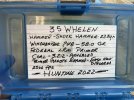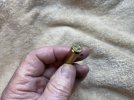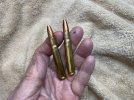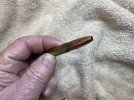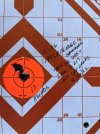View attachment 428319
PART 3/3 - THEORIES AND QUESTIONS FOR REPORTED OBSERVATIONS:
Here are some thoughts, along with some questions for Steve from Hammer Bullets, regarding the discrepancies in theories between powder charges / types, pressure, and velocities for the Hammer-type (mono-core projectile with driving bands) bullets compared to standard cup and core bullets, specifically the comments that Hammer-type bullets can not achieve higher velocities without significant increases in pressure.
From my understanding, the bullet material used to make the Hammer Bullets is similar to the jacket material on cup and core bullets. Therefore, the lubricity and surface hardness should be similar. However, in cross-section, the homogenous copper Hammer Bullets are likely more resistant to deformation and compressive forces compared to the cup and core bullets which have a thin jacket over a much softer lead core. Also, It has also been stated and demonstrated in the literature, that a certain amount of pressure is required to build up for proper powder burn to occur and to build up significant enough pressure to obtain maximum velocity.
Is it possible that when the initial ogive contact of the Hunter bullets or first driving band of the Absolute bullets contacts the leade of the barrel and begins to engrave all the way up to full land height, that this restriction in bore diameter and bullet movement provides enough increase in pressure to allow sufficient powder burn and also to raise pressures high enough to obtain maximum velocity, similar to standard cup and core bullets. However, although the initial ogive contact ring on the Hunters and band on the Absolutes is narrower than the full bearing contact surface on a standard cup and core bullet, the fact that there is less compression of the solid copper cross-section of the hammers compared with the jacket and lead core of the standard bullets provides the additional resistance necessary to reach peak chamber pressures. Thus, at least partially negating the argument that the Hammer bullets do not reach enough initial pressure to obtain reported velocities without excessive pressure.
Assuming the above (that the Hammers can and do reach sufficient pressure once the bands contact the leade and engrave the rifling), once the peak pressures and burn are achieved and the bullet is moving down the barrel, this is where the differences in bullet design likely significantly affect the end results. The driving bands now provide a much lower degree of friction compared to traditional bullets with a full diameter bearing surface. This reduced friction is likely reached for several reasons: 1) The total surface area of the bearing surface is reduced by the fact that there is only contact with the bands, which themselves are significantly reduced due to the parabolic shape; 2) The grooves between the bands provide space for the displaced copper material from the bands to move, also reducing resistance to movement; 3) Cup and core bullets are known to fully obturate to the bore due to the pressure of the expanding gases upon the base of the bullet as well as the bullets resistance to the initial forces of acceleration. Due to the softer lead core, the bullet will deform substantially more than the mono-cores, leading to more complete contact of the lands and grooves for the entire length of the bearing surface, as well as more pressure being exerted on the lands and grooves due to the greater degree of deformation. I have seen pictures of recovered mono-core bullets that show that the driving bands do fully engage the rifling, and that the driving band material will "wipe" back and fill the following groove. However, it appears that the remainder of the bullet does not deform further to fill the gaps between the driving bands of the mono-cores and the bore like is seen in cup and core bullets and cast bullets.
Interesting topic, and I hope this provides food for thought and discussion. I have my Absolute Hammers and Hammer Hunters loaded and ready for a break in the weather and day off. Best wishes. Mike D.

